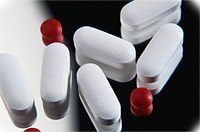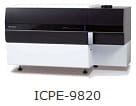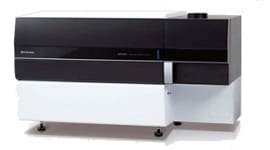Analysis by ICP Atomic Emission Spectrometry in Accordance with the ICH Q3D Guideline for Elemental Impurities

At the International Conference on Harmonisation of Technical Requirements for Registration of Pharmaceuticals for Human Use (ICH), a variety of guidelines were created and harmonized through three-party cooperation between Japan, the United States and Europe. The guideline for elemental impurities is under review as "ICH Q3D". In this guideline, the permitted daily exposure (PDE) was established for 24 elemental impurities for which toxicity is a concern. They include lead (Pb), cadmium (Cd), mercury (Hg), and arsenic (As), the "big four", as well as residual catalytic metals added intentionally in the synthesis of a drug substance.
An ICP atomic emission spectrometer enables quick and easy analysis of multiple elements. The Shimadzu ICPE-9820 multitype ICP atomic emission spectrometer can perform a batch analysis of these target elements.
Sample Pretreatment

An analysis was performed on an eye drop solution and on tablets (daily intake: 1 tablet (0.2 g)). Nitric acid and hydrochloric acid were added to the eye drop sample, and it was diluted 5 times with pure water to obtain the measurement solution. Two of the tablets were dissolved with nitric acid and hydrochloric acid using a microwave digestion system. The sample was filled up 20mL for the measurement solution (50 times dilution).
Analysis and Results
The Shimadzu ICPE-9820 multitype ICP atomic emission spectrometer was used as the analysis system. The ICPE-9820 is equipped with an Echelle spectrometer and a CCD detector, so the instrument is capable of simultaneously analyzing all elements and all wavelengths. This enables high-throughput measurements even when there are many target elements and samples. In addition, the instrument is equipped with a mini torch and a vacuum spectrometer, substantially reducing the running costs for gas in comparison to other ICP instruments.
In this measurement, quantitative analysis and additive recovery tests were performed on 24 elements cited in the ICH Q3D by the calibration curve method – internal standard method. Table 1 shows the analysis results for the eye drop solution, and Table 2 shows the analysis results for the tablets. Favorable results were obtained for the additive recovery rates for both samples (columns marked with *1 in Tables 1 and 2). In addition, the detection limits calculated from the concentrations in the samples (columns marked with *2 in Tables 1 and 2) sufficiently satisfied the permitted concentrations (columns marked with *3 in Tables 1 and 2).
The definitions for the terms, permitted concentration, concentration after treatment, additive concentration, converted detection limit, and <DL in Tables 1 and 2 are shown below Table 2.
Table 1: Analysis Results for the Eye Drop Solution
| Element Name | Parenteral PDE |
*3 Permitted Concentration | Concentration After Treatment |
Additive Concentration | Measurement Value (In the Tablet) |
*1 Additive Recovery Rate |
*2 Converted Detection Limit in the Tablet (3σ) |
| μg | μg/mL | μg/mL | μg/mL | μg/mL | % | μg/mL | |
| As | 15 | 15 | 3 | 1 | <DL | 104 | 0.04 |
| Cd | 2 | 2 | 0.4 | 0.4 | <DL | 101 | 0.0006 |
| Hg | 3 | 3 | 0.6 | 0.3 | <DL | 105 | 0.007 |
| Pb | 5 | 5 | 1 | 0.3 | <DL | 102 | 0.01 |
| Co | 5 | 5 | 1 | 0.3 | <DL | 95 | 0.001 |
| Ni | 20 | 20 | 4 | 0.5 | <DL | 104 | 0.003 |
| V | 10 | 10 | 2 | 0.5 | <DL | 98 | 0.0008 |
| Ag | 10 | 10 | 2 | 0.5 | <DL | 104 | 0.0008 |
| Au | 100 | 100 | 20 | 0.5 | <DL | 99 | 0.006 |
| Ir | 10 | 10 | 2 | 0.5 | <DL | 101 | 0.01 |
| Os | 10 | 10 | 2 | 0.5 | <DL | 103 | 0.006 |
| Pd | 10 | 10 | 2 | 0.5 | <DL | 102 | 0.004 |
| Pt | 10 | 10 | 2 | 0.5 | <DL | 99 | 0.02 |
| Se | 80 | 80 | 16 | 0.5 | <DL | 103 | 0.02 |
| Rh | 10 | 10 | 2 | 0.5 | <DL | 95 | 0.007 |
| Ru | 10 | 10 | 2 | 0.5 | <DL | 103 | 0.003 |
| Tl | 8 | 8 | 1.6 | 0.5 | <DL | 95 | 0.02 |
| Ba | 700 | 700 | 140 | 0.5 | <DL | 96 | 0.0006 |
| Cr | 1100 | 1100 | 220 | 0.5 | <DL | 97 | 0.002 |
| Cu | 300 | 300 | 60 | 0.5 | <DL | 96 | 0.002 |
| Li | 250 | 250 | 50 | 0.5 | <DL | 99 | 0.01 |
| Mo | 1500 | 1500 | 300 | 0.5 | <DL | 100 | 0.003 |
| Sb | 90 | 90 | 18 | 0.5 | <DL | 103 | 0.010 |
| Sn | 600 | 600 | 120 | 0.5 | <DL | 100 | 0.01 |
Table 2: Analysis Results for the Tablet
| Element Name | Oral PDE |
*3 Permitted Concentration | Concentration After Treatment |
Additive Concentration | Measurement Value (In the Tablet) |
*1 Additive Recovery Rate |
*2 Converted Detection Limit for the Tablet (3σ) |
| μg | μg/g | μg/mL | μg/mL | μg/g | % | μg/g | |
| As | 15 | 75 | 1.5 | 0.5 | <DL | 107 | 0.5 |
| Cd | 5 | 25 | 0.5 | 0.1 | <DL | 100 | 0.007 |
| Hg | 30 | 150 | 3 | 1 | <DL | 101 | 0.1 |
| Pb | 5 | 25 | 0.5 | 0.1 | <DL | 98 | 0.07 |
| Co | 50 | 250 | 5 | 1 | <DL | 101 | 0.01 |
| Ni | 200 | 1000 | 20 | 1 | 0.1 | 100 | 0.03 |
| V | 100 | 500 | 10 | 1 | <DL | 103 | 0.01 |
| Ag | 150 | 750 | 15 | 1 | <DL | 104 | 0.02 |
| Au | 100 | 500 | 10 | 1 | <DL | 105 | 0.03 |
| Ir | 100 | 500 | 10 | 1 | <DL | 100 | 0.09 |
| Os | 100 | 500 | 10 | 1 | <DL | 85 | 0.04 |
| Pd | 100 | 500 | 10 | 1 | <DL | 106 | 0.05 |
| Pt | 1000 | 5000 | 100 | 1 | <DL | 102 | 0.3 |
| Se | 150 | 750 | 15 | 1 | <DL | 108 | 0.3 |
| Rh | 100 | 500 | 10 | 1 | <DL | 101 | 0.1 |
| Ru | 100 | 500 | 10 | 1 | <DL | 100 | 0.03 |
| Tl | 8 | 40 | 0.8 | 0.1 | <DL | 103 | 0.2 |
| Ba | 1400 | 7000 | 140 | 1 | <DL | 102 | 0.003 |
| Cr | 11000 | 55000 | 1100 | 1 | <DL | 101 | 0.02 |
| Cu | 3000 | 15000 | 300 | 1 | <DL | 105 | 0.05 |
| Li | 550 | 2750 | 55 | 1 | <DL | 104 | 0.1 |
| Mo | 3000 | 15000 | 300 | 1 | <DL | 101 | 0.03 |
| Sb | 1200 | 6000 | 120 | 1 | <DL | 105 | 0.1 |
| Sn | 6000 | 30000 | 600 | 1 | <DL | 100 | 0.03 |
Permitted concentration:
The permitted concentration when 1 mL of the eye drop solution is used per day. For the tablets, the permitted concentration for the daily intake (0.2 g).
(The caliculation to convert PDE to concentration is used option 3 that is calculation of concentrations for the finished product.)
Concentration after treatment:
The permitted concentration limit in the measurement solution after the sample is pretreated.
Additive concentration: The additive concentration in the solution used in the additive recovery test
Converted detection limit in the eye drop solution (3 σ):
The detection limit in the measurement solution (3 σ) × the dilution rate (5)
Converted detection limit for the tablets (3 σ):
The detection limit in the measurement solution (3 σ) × the dilution rate (50)
<DL: Less than the detection limit (3 σ)
Reference Material: ICH Q3D Guideline for Elemental Impurities (STEP 2b)
-------------------------------------------------------------------------------------------------------------------------------------
ICPE-9800 Series Simultaneous ICP Atomic Emission Spectrometers

ICPE-9800 Series of simultaneous ICP atomic emission spectrometers are next-generation systems that offer the superior accuracy necessary to simultaneously and quickly analyze multiple elements regardless of their concentration levels. They also feature user-friendly software that makes analysis easy. Furthermore, the systems reduce analysis costs while providing the highest performance levels in the industry. ICPE-9800 Series systems represent the ultimate in ICP atomic emission spectrometry for environmental, pharmaceutical, food, chemical, metal, and other fields.


